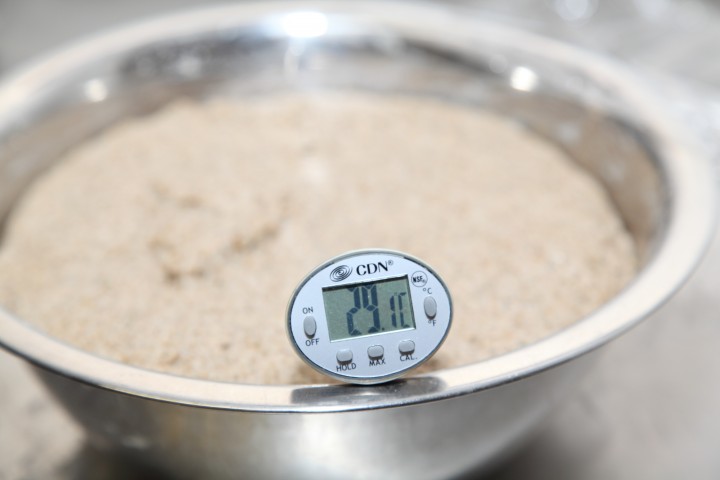
Not ‘sort of’ or ‘just about’… I want to know exactly!
One thing we learned during our baking adventures is to keep an eye on the temperature of the dough. In our micro bakery the temperature fluctuates between 13ºC/55ºF in the winter and 26ºC/79ºF and upwards during summer. Believe me, this temperature difference has a big impact on the end result of your loaf. When you are baking a lot of loaves in batches and want to get consistency in your end product you need to control the temperature of your dough.
Some tough theory
Below is a chart for the L. sanfranciscensis lactobacillus and C. milleri yeast which both are common in sourdoughs. Commercial regular active yeast contains the species S. cervisiae. The type C. milleri is very common in sourdough breads and it does work better at lower temps, but S. cervisiae actually peaks it’s activity at about 35°C (95°F).
A few degrees difference in dough temperature can change the duration of the bulk fermentation or the final proofing a lot. When baking bread with regular active dried yeast, the optimum (for speed alone) temperature is just over 27ºC/80ºF.
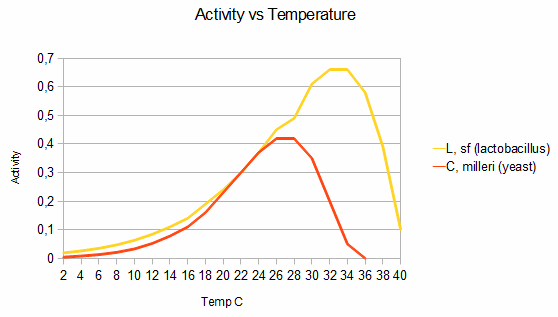
Much warmer and the activity of the yeast declines. Above 35C/95F the yeast is effectively dormant or dead. The bacterial activity peaks at 34C/93F, so some bakers choose to ferment at 32C/90F to get a more sour bread. At 21C/70F the activity of the yeast has roughly halved, so the fermentation will take twice as long.
The right temperature is the single most critical variable. The growth rate of for example the L. sanfranciscensis lactobacillus and C. milleri yeast is ln2 / generation-time, i.e. a growth rate of 0,7 is a generation (doubling time) of about 1 hour.
If the generation time within your dough at 20ºC/68ºF is 1/2 of that at 30ºC/86ºF, the organism will also grow 1/2 as fast at 20ºC/68ºF compared to 30ºC/86ºF. So, it’s not the absolute numbers that matter, but the ratio of growth rate to growth rate at optimum temperature.
Practical tips for consistency
To get consistent bulk fermentation and proofing times, we aim for a dough temperature around 24ºC/75ºF. This is a temperature which gives you a nice balance between speed and taste. You can reach and keep the temperature of your dough with the following techniques;
- Invest in a good digital thermometer; We use a CDN DTQ450X ProAccurate Quick-Read Thermometer and a Thermapen which are both excellent, stable and fast.
- Use warm water in the winter or cold water in the summer to get the dough to the right temperature.
- The temperature of the water depends of the temperature of your room and the temperature of the other ingredients. For example our Pain Rustique uses a 50% preferment to final dough ratio and thereby uses 72% of the water in the the poolish. In winter we sometimes need very hot water (up to 55C) to get the poolish and the new flour up to 24ºC. However when using a lower preferment to final dough ratio, water of about 30C is often enough to get to 24ºC.
- Try to keep the dough at a stable temperature. We sometimes put a bowl of dough on top of the Rofco oven covered with a tea towel and on top of a folded towel. Also a preheated and switched off oven to about 30ºC (use a thermometer to measure the inside temperature as your dial on the oven will probably not be very helpful) will work great.
- Some people build their own proofing cabinet, using an old refrigerator or kitchen cabinet. With the help of an old 40 Watt or 100 Watt light bulb (depending on the size of the cabinet) on the bottom of the cabinet (warm air rises from bottom to top!) you can easily heat the inside of your cabinet. You can use a simple mechanical thermostat to switch the bulb on and off to control the temperature.
- When you do not have the means to control the environment temperature of your dough, in summer you can make your dough a few degrees colder and in winter a bit warmer to compensate for the rise or decline in temperature.
- Water and flour have a different thermal capacity. In bread baking this translates to the influence of water on dough temperature being twice that of flour. The dough calculator you’ll find in most of our bread recipes takes this into account.
Want to learn more on calculating the right water temperature?
Check out this posting on the Wild Yeast blog





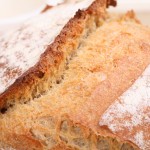

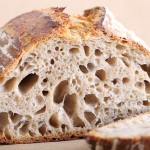
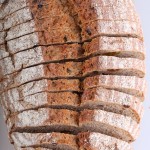
Kelvin says
Great article. Learned a lot from this.
One thing I can’t figure out is if we’ve adjusted the water temperature to get the DDT according to the flour temp and room temp. For the 2+ hr bulk fermentation, do we need to worry about room temperature? I see some people use a bread proofer for that. Can’t we just leave it in room since we’ve already adjusted for DDT with water temperature?
Thanks in advance.
Kevlin
Mathias says
Could I please get a citation for the graph you are showing on yeast temperature curves
Wood Chalene says
I am new to sourdough, I thought my starter would be most happy in the oven with the light on. The first day she loved it and thrived and now last night she might have died. I took her temp this morning and she was 86 degrees. Did I kill her? She didn’t rise at all after the 5 pm feeling.
Athanas Musvari says
Hi,
Thank you very much informative. I live in South Africa and average temperatures in summer season range from 27C to 34C. What will be the ideal temperature and humidity for proofing reducing proofing time.
Regards
ARM
Weekend Bakers says
Hello Athanas,
We cannot really say this without knowing the recipe, but in general closer to 27C would be preferable.
Dennis Peter says
If using an instant yeast rather than an active dry yeast, do i still need a warm water or milk or just a plain water? Thank you.
Liza says
Helo i lived in tropical country there always around 30 C. Do i need to speed up?
Weekend Bakers says
You can either use less yeast or speed up the process, just always keep and eye on your dough to avoid over-proofing!
Josephine D'Souza says
Hello and thanks for your tips. What oven temperature do you recommend for a 2nd prove of doughnuts? Thxs
Weekend Bakers says
Hello Josephine, we are no experts but we think a warm room temp of 24 to 25 C would be best. Like with all dough, keep an eye on them during this final stage!
Ileana says
Difficult for me living in the tropics since humidity is very high.
I would like to ask about percentage of hydratation where can I find info about it, because I don’t bake for business just for fun at home and I don’t know about it….
Thank you,
Weekend Bakers says
Hello Ileana,
It is challenging to bake with high humidity and heat. There are many things you can do to help the situation. Above all you need to decrease the amount of liquid in a recipe and extend the baking time. It is hard to say by how much, because this is dependent on your humidity level. You would need to measure this too. We do not have a table for this but if you google the subject you will find some helpful information from several sources. We would start to reduce the liquid (in general) by 5 to 10%. When increasing baking time, you increase by a few minutes and always keep an eye on your bake to check how it is going.
Good luck with it!
Chard says
Hi! Im only new to dough and been experimenting with cinnamon rolls and doughnuts. Im really into doughnuts right now and noticed that cold fermenting my dough gives it more a desirable taste, texture, and (color??). But i wanna do this properly, we have a chest freezer that’s been set for 0degree celsius and refrigerator for 15degree celsius. Ive tried both of them and cant really notice if it grew bigger than the other(i made them in different days), i also tried deflating the dough in the refrigerator 3 times(I deflated it once every hour for 3 hours) and let it completely rest for the rest of the 12 hours(minus 3 hours) . The question is what temperature shoul i set my fridge/chest freezer?, is it necessary to deflate the dough a few times while in the fridge?, i found a couple of websites that says i should let the dough rest for 30 minutes and deflate then put it in the fridge(didnt say anything about deflating for a few times while in the fridge), Some websites/artcile says rest it for 1 hour then put it in the fridge, some says 2-3 hours and deflate then put it in the fridge, and one website says put it directly in the fridge and delfate for a few time formthe first few hours. What is you say or recommendation?.
Sorry for making you read this long comment and making you answer tons of question at a time😊😊..
Weekend Bakers says
Hello Chard,
We really are no experts on doughnut dough. In general we never deflate dough while it is fermenting in the fridge. We are surprised to read your fridge is 15 C, is this really correct? Most fridges (as far as we know) are set to about 6 to 7 C, this is also a temperature that is recommended for many products when it comes to shelf life.
So if and when we keep dough in the fridge it is at a temperature of around 6 C and depending on the recipe, we give the yeast a head start and let it develop at room temp for around 1 hour.
There are many valid methods that can all be slightly different and you need to find your own favorite by experimenting a bit .
Above all, you need to put three things together: The temperature, the amount of yeast and the time it takes to develop your dough.
You can use the table in this post about pizza dough for this:
www.weekendbakery.com/posts…gh-recipe/
Good luck with the project and make sure you do not keep your milk and cheese and stuff at 15 C 😉
Ariel says
Many thanks for the usefult tips! Leaving in a hot country this is definitely something I need to take into account (and I do, occasionally :-)). One question, though. For sourdough bread autolyse my recipe specifies 2 hours (first hour without salt and another hour with salt added). This assumes 21C (not specifically for autolyse, just a general guideline). Do you think I should adjust this timing for 28-30C?
Weekend Bakers says
Hello Ariel,
We do admire your baking in a hot and often humid country, we know it has its challenges. You can either adjust the time or also (partly) use the fridge. Please keep in mind we do not know your recipe but we think as a start you can easily take one hour instead of the two.
Just give it a try and always realize you have to make a recipe at least 4 to up to 10 times to get it to be perfect for your conditions!
Enjoy the process
Cindy Cottin says
I am pretty new to bread baking. We are in a heat wave and we don’t have air conditioning. I used ice water to proof the yeast but I was attempting a bread with a 12 hour fermentation (only using 1 gram of instant yeast). I left it in the oven on the proof cycle thinking the temperature would stay constant and at optimal level as long as the door stayed closed, but I checked this morning to find the yeast is dead and the dough completely crusted over. Checked the temperature of the dough to find it at nearly 40 degrees celcius. 🙁
My question is – is there some way I could have prevented this from happening? How would I have been able to keep the dough cool enough, or do I just need to give up the idea of a 12 hour fermentation while I am in a heat wave (33 degrees celsius is the expected high temperature today).
Thank you!
Weekend Bakers says
Hello Cindy,
No worries, you just need to use the fridge to slow things down. If you want an overnight preferment 12 hours in the fridge, provided the fridge is 6/7 Celsius, you can put in 1 gram instant yeast for each 100 gram flour you use (maybe slightly less). The 1 gram yeast you used with these temperatures you mention was over the top level of what yeast is able to take.
It is far better to use an even under-developed preferment which still has some more oomph to give to the final dough.
Even with a room temperature of 25 C you would have needed far less yeast (think ten times less) than you used.
The fridge will be your friend!
Good luck with it.
Cindy Cottin says
Thank you very much. 🙂 I still have a lot to learn but I am having fun with the process.
Cindy Cottin says
Also just checked the recipe. The same recipe is in my book three times with three different fermentation times and three different amounts of yeast. In all three cases, it uses 500 g of flour. Recipe 1 is 8 grams instant yeast, 1.5 hours fermentation. Recipe 2 is 3 grams instant yeast, 8 hours fermentation. And the one that failed was recipe 3 – 1 gram instant yeast, 12 hours fermentation. Recipes 1 and 2 worked fine, and recipe 2 tasted considerably better than recipe 1. Do these numbers make sense to you?
Weekend Bakers says
Hello Cindy,
The numbers and amounts can add up. You also have to take into account the rest of the method / recipe and also the temperatures given. Sometimes (maybe even often) there are recipes with mistakes in them, also in books, but it is hard to say. Why not try one of our recipes, that other bakers had success with too?!
Eva Petric says
Hello, thank you for the tips- but i still don t know how long for should i leave my sourdough bread on the average temperature 25-30 degrees celsius in summer and 15 degrees in winter?
Weekend Bakers says
Hello Eva,
The fermentation at between 25 to 30 degrees (there is a ‘plateau’ at these temperatures where the proofing time is not very different between 26, 27, 28, 29) will in general go 4 times as fast as at 15, so your loaf would have to proof 4 hours at 15 while only 1 hour would suffice at around 30. This is a generalization, because there are always factors to consider that will account for differences, not in the least the composition and ‘enthusiasm’ of your own culture.
That is why we also want to advice you to use the method we describe in this post for checking if your dough is ready for the oven:
www.weekendbakery.com/posts…e-in-size/
Enjoy your sourdough baking!
sandeep ubhi says
hi dear
I try to croissant dough loaf 500 grams and every times I put in to proofer rise nice but soon as I pull out from proofer start claps very quick I use temp 30.c and humidifies 85 can you please tell what is I am doing wrong why this happened all the time
Boguslaw says
“Some people build their own proofing cabinet”
I use for proofing and 4 stages rye flower souerdough starter:
– small kitchen cabinet
– Inkbird ITC-308 Digital Temperature Controller 2-Stage Outlet
Thermostat Heating and Cooling
– lamp with 40W bulb for heating
– small fan and backet of ice for cooling (never used)
Works good
Weekend Bakers says
Thank you Boguslaw, for sharing this information with us and other bakers. We are sure it will inspire more self build projects!
Sharon Kaye Shumpert says
I just purchased a Brod & Taylor Proofing Box. It has kicked up my baking skills! It saves me for when I need to use my regular oven. It also serves as a yogurt maker and slow cooker.
Weekend Bakers says
Congrats Sharon, sounds like a great thing to have. We do not have any experience with this, but Ed has built a proofing box himself which also works really well!
Stuart Soffer says
I have an oven wirh proofing options what temperature do I need for proofing and how long.
Weekend Bakers says
Hello Stuart,
What recipe are you making and are you using regular yeast or sourdough?
Bhawesh says
Very informative for beginners
Will certainly try this winter.
Weekend Bakers says
Thank you and enjoy your Winter baking!
Ana says
Hi! I wanted to ask what can be used when the ambient temperature is over 35C? Ive been experimenting and was told to add ambient temperature to flour temperature and then the water should be in at a temperature that all three equal 56C.. But often by this calculation it should be under 0.. Does this affect the flavour as well at the fermentation time and could I put into a fridge intermittently?
Weekend Bakers says
Hello Ana,
Yes you are right, in hot climates it could even be valid to use ice water. The calculation also depends on the handling of the dough / kneading because this adds warmth too. So it is very helpful if you can measure everything with digital thermometer and get to an ideal temperature after kneading of around 24 to 26C, which for us is the right optimum when looking at speed and taste.
Depending also on the use of commercial yeast or sourdough, because with sourdough it is better to stay on the lower side and commercial yeast has its peak at a higher temp as you can read above, so you will have less problems with a yeast bread if the dough tends to get warmer.
And if needed you can always put your dough in the fridge. You can experiment with retarding the dough (after shaping) in the fridge overnight too.
Good luck with it, because it is always more of a challenge to bake in warm and humid conditions.
elsayed says
It is an easy method and does not need time, which is the outcome of our experience and study. We are graduates of the Bachelor of Food Technology 1982 Zagazig University Faculty of Agricultural Sciences moshtoher city
First we talk about the sources of heat during mixing
1. Heat of the mechanical friction factor of the mixing motor
2 – heat of the transition heat hydration resulting from a change in the level of energy when the absorption of water in the case of mixing occurs in the rise in temperature
Therefore there must be a way to prevent the heat from the desired level
They use ice or ice water or cooled mixing or cooling mixing blades
Until we get the dough temperature between 25 ° C
We have
Deepankar Gupta says
Wow. Thank you for this.
My room temperature is 85F and i keep following recipes that call for “warm” water to be added!!!! Silly!
Please could you help me…
I am trying to make the very basic poolish based bread, using a t65 flour. Results have been good but not wow. And i have some definite pressure points.
1. A 1:1 poolish is quite dry
2. Am using a kitchenaid style dough mixer. Could you ballpark machine setting and mixing times to get the ideal dough? (I read somewhere that initial mixing should be lower setting) i am just not able to get that right.
Do you suggest an autolyse after that?
I am just unable to develop the gluten.
Thank your for your time
Dee
Weekend Bakers says
Hello Dee,
What flour are you using for your bread and at what speed are you kneading now? Does your dough tend to stick to the hook?
elsayed says
type T65 is ideal for making baguettes and artisan dark breads used spiral arm mixer to get develop gluten
Chami says
When I put sourdough in the fridge overnight, it seems very stiff and cold and takes forever to come to room temperature and doesn’t rise well in the oven. Can I let it do final proof outside- dry Arizona heat, 87-95 F?
Weekend Bakers says
Hello Chami,
There are several things you can try, including a combination of first an hour or so at ‘room temp’ before you put it in the fridge, a shorter fridge time, taking it out sooner or no fridge at all, maybe with less yeast. So try and experiment with these factors and your recipe and make sure to cover your loaf well so it does not dry out.
Good luck with it!
Roland Maurice says
Thanks for the tid-bits. What happens if the temperature fluctuates for dough that takes a long time to rise? If it’s in a cool environment for the beginning and then the room gradually warms up or; if it starts out warm, cools down, and then warms up again? Like, if you started the rise, suddenly had to leave and threw it in the fridge, and then got back later and took it out of the fridge to finish the rise?
Weekend Bakers says
Hi Roland,
In general, for a good result it is best to have a stable and draft free development environment and stick to the recipe. But it also depends on what that recipe is exactly, the ingredients and your goal in terms of structure and taste. So it does not have to be a problem, but you need to keep an eye on it and also make sure the dough does not dry out.
See for example our baguette recipe:
www.weekendbakery.com/posts…-baguette/
And the San Fransisco style sourdough:
www.weekendbakery.com/posts…ugh-bread/
The dough can go from warmer to cool and back again, but it all needs to come together with the right amount of yeast, type of flour and development time.
So your method could work, no problem, as long as the dough does not over-develop or the recipe is somehow not suitable for longer fermentation.
Elie says
Do you have suggestions on how to control the humidity?
I am thinking of getting a hygrometer to tell me the humidity in my kitchen and a humidifier for the winters to bring up the humidity.
My quality control is going to be shot going into this dry season now!
Weekend Bakers says
Hello Elie,
The obvious way to go for some bakers would be a proofing cabinet, but that can be very expensive and it all depends on how many loaves you want to make in one go. Another option, which will benefit your dough, your surroundings and yourself, is indeed buying a humidifier for your room. We have one in a room with wooden floors (a ‘Venta’ from Germany) and are very happy with it, both for the floor and ourselves.
Good luck with it!
Ittay says
Do you have a correlation chart for feeding that shows the relation between activity (temperature), hydration, and starter percentage?
Weekend Bakers says
Hi Ittay,
The only thing we can point you to is a correlation between temperature and yeast activity in pizza dough. See: www.pizzamaking.com/forum…#msg529996
Ewouda van Rooyen says
I’m apparently doing something wrong! My bread falls flat, although just a little on top. I never had that problem before. I know the African sun can be harsh, so I am being cautious. It happens after +/- 15min in the oven. Any suggestions?
Weekend Bakers says
Hello Ewouda,
Could have either something to do with the oven and temperature, with the flour you are using and with possible over-proofing (proofing faster in African sun) or even a combination to make things more difficult.
Maybe you can check our oven tips first to see if something clicks and check nothing is wrong there (plus lots of good tips that might help improve your result):
www.weekendbakery.com/posts…your-oven/
Also important: Do not open the oven door during the first stage of the baking process!
Jane says
Hi! Is there a machine or equipment we can use for our proofing room to have a stable temperature, other than humidifier?
Weekend Bakers says
Hello Jane,
You can buy professional proofing cabinets or you can make a proofing cabinet from an old refrigerator, but for this you need some technical know how. Some people build proofing boxes. You can find examples on the web.
Other than this and using you own oven as a proofing space we would not know.
Alex says
There is a great and affordable proofing cabinet that folds down to store away in a drawer- made by Taylor and Brod. I highly recommend.
Weekend Bakers says
Thank you for sharing Alex.
sahar ebrahimi says
what is the optimum humidity for saccharomyces cerevisiae ?
Weekend Bakers says
Hello Sahar,
We do not know the exact answer to this. Hope somebody else does.
elsayed says
humidity is 80% temperature is 30C
Ekhi says
Amazing article! I was wondering how much time in the fridge (retarding fermentation) I would need comparing to room temperature for the fermentation and make my recipes more flexible. Any input from that?
Do you recommend any book or other info regarding this? (e.g., amount of yeast vs. fermentation time vs. temperature).
Thanks!!
Weekend Bakers says
Thank you Ekhi,
Time in the fridge, it depends on the recipe, the amount of yeast or sourdough and the temperature of the fridge and the conditions when the dough is made (room temp and dough temp, humidity) . So you need a point to start, for example reduce the yeast by halve and put your loaf in the fridge overnight (take around 12 hours to start), and see where it leads. It is a bit trial and ‘error’ but within 2 or 3 attempts you will get it right for your conditions. This would be the quickest and easiest way to go about it.
The best book we can recommend, with lots of info on many related subjects and still accessible for the home baker is ‘Bread’ by Jeffrey Hamelman.
Enjoy your baking and retarding!
Chris Kantarjiev says
A trick I’ve started using lately in my kitchen, which is usually too cool, is to do my bulk fermentation with the dough bucket sitting on top of an electric heating pad. The “low” setting is just about 80 degF, and the bucket is insulated enough that the dough mass stabilizes nicely around 77 degF.
When the kitchen is really cool, I’ll do the second rise in the closed oven with the heating pad in the bottom of the oven. But I have started to settle on letting the second rise go more slowly to develop a bit more of a sour flavor… your graphs and equations are a great explanation of what I’ve learned through experimentation!
Weekend Bakers says
Hi Chris,
Thank you very much for sharing your excellent tips with us fellow bakers.
Great how you experiment to get your loaves just right!
And thank you for your kind words.
Wishing you many crusty sourdough loaves,
Ed & Marieke
Sai says
A big challenge for lot Indian folks is making ‘Idli’… where we soak & later grind rice & urad dal(black gram lentil)… the batter has to ferment & double to get fluffy idlis once steamed ( ellipsoid rice cake).
In US & other cold countries it can take 2-3 days in winter …. usu it ferments in 12 hrs in tropical countries.
No yeast is added… any suggestions to get consistent fermentation pl
Weekend Bakers says
Hello Sai,
We have heard of Idli but have absolutely zero experience with it. The only thing we can say that consistent fermentation needs consistent conditions. We know you can buy a dough proofer that is also used to ferment yogurt for instance (Brot & Taylor has one) that could be an option for you or you could use your oven, which you preheat to a the desired temp and then turn off.
Hope this helps you a bit in the right direction.
Good luck with it!
Masala Devi says
Using the yogurt setting in an Instant Pot for 8-12 hours produces an excellent idli fermentation.
Weekend Bakers says
Thank you Masala for sharing your advice!
Dakusuk Yohanna Gabriel says
I am grateful to come a cross the procedure,
i like it .
Weekend Bakers says
Thank you Dakusuk, hope it will help you with your baking too!
Debbie says
Does the temperature by 5 degrees Messa up your baking ?my husband said it make a difference?
Weekend Bakers says
Hi Debbie,
It depends on a lot of things..what recipe, do you mean Celsius or Fahrenheit, do you use yeast or sourdough et cetera. But in general, too low and the development is slowed down and too high the yeast will eventually die.
Zanzoona says
Is it suitable way and gives a good results if I use my baking oven at 25°c temperature? I think it’s better than to leave it at the room temperature coz the oven is stable and well-reserved!!
Weekend Bakers says
Yes Zanzoona, that’s excellent. Just give it a go!
Zanzoona says
Thank you so much dear friend ☺ ☺. I have my yeast in envelopes of 20g, and this’s a very big amount for any recipe! Can I use the envelope for many times? Thank you again
Weekend Bakers says
Yes you can, just make sure to seal the bag and store it in an airtight container, that would be best and do not use it past the sell by date, because the working of the yeast can get less as it gets older.
Zanzoona says
I’m thanking you from my heart. I’m still waiting for your choux recipe and I’ll not move to another site. Pls accept my greetings and my best wishes 4all of you: MERRY CHRISTMAS AND HAPPY NEW YEEEEEEEAR 🎇 🎄 🎊 🎄 🎉 🎄 🎁 🎆 🎇 🎊 🎉 🎆
Weekend Bakers says
Thank you and best wishes for you and your loved ones too!
We hope to finish the choux recipe within the coming week.
Weekend Bakers says
We hope the choux recipe will be live ultimately tomorrow, so check our site and keep an eye out… 🙂
Martin Earl says
Regular active yeast is the species S. Cervisiae, not C. Milleri. C. Milleri is very common in sourdough breads, and it does work better at lower temps, but S. Cervisiae actually peaks it’s activity at about 35°C (95°F). The chart you’ve presented looks like it’s based on the same data as that presented in Ginsberg’s The Rye Baker, and it does hold true for sourdoughs, but not for active dry yeast.
See: On food and Cooking (McGee, pg 538) and
the Bread Bible (Beranbaum, pg 30)
Weekend Bakers says
Thank you Martin, for this helpful information. Based on this we will look into your suggestions and also update our article.
Lance Williams says
I have seen that chart many times (I think it was from a paper by Gaenzle) & believe it is highly misleading and I try & challenge its use whenever I see it. The dominant yeast in sourdough is S. cerevisiae and as Martin states, this has a higher peak activity temperature than C. milleri and stays viable up to much higher temperatures. Also L. sanfranciscensis is not a major component of the lactobacillus species in most starters and often isn’t present at all! Have a look here to confirm: robdunnlab.com/proje…dough/map/
Graham says
This is awesome! Is the data from the chart of activity level vs temp available somewhere? I’d love to be able to make a quick excel sheet to adjust my timings based on temperature (my kitchen swings wildly so its hard to get a stable read)
Weekend Bakers says
Hi Graham,
Very sorry, there was a site with info the chart was based on but we cannot seem to find it anymore. Hope you will still be able to fabricate an excel sheet to aid you with your challenging temp swings.
Roslyn says
About a year ago I retired and moved to Tennessee from Virginia. In Virginia and I always made homemade rolls and they came out perfect. I have not made a good pants since I’ve been here and can’t figure out the problem. I have a new Viking double oven and everything else in my recipe is the same. I have put my oven on so many settings and what happens is they will rise but somehow during the baking process they’re not as high as they were in Virginia. Any suggestions?
Weekend Bakers says
Hi Roslyn,
This is an interesting and very tricky question which may have several causes. First of all your oven is different and it is a good idea to check the real temperature of your oven (see: www.weekendbakery.com/posts…your-oven/) and see if it is all working properly. Next, did you maybe buy (different) flour from a new source since your move, because this can also make a very big difference. And also there’s the climate (moisture) and the altitude that can account for variations in results too. We do not know enough about the differences between the two states and places to help you with that, but there is info to be found on the subject should it be a factor.
Good luck with it and hope the buns will rise high again!
Hope you will figure it out.